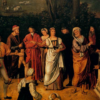Divide and Prosper: A Historical Account of Church-Planting by “Peaceable Division”
Four years after De Tocqueville published his Democracy in America, the British Baptist Union took up their own interest in the promising developments unfolding on the other side of the Atlantic. Their concerns, however, were more specific. They weren’t so much interested in the societal make-up of nineteenth century America as they were the inner-workings of Baptist America. Thus, on March 12, 1835, in a spirit of inquiry no less searching than De Tocqueville’s, the Union’s official deputation of two respected British ministers, Francis Augustus Cox and James Hoby, set sail from Liverpool for New York. They were expressly commissioned “to acquire information respecting the proceedings of American Christians, particularly those of our own denomination, and to endeavor to unite in closer bonds of affection and fellowship our brethren in a distant land, first, by a representative intercourse at the Triennial Convention, and then by a visit to their churches” (47). And did they deliver!
The following year, The Baptists In America: A Narrative of the Deputation From the Baptist Union in England to the United States and Canada was published as a 476-page tome of unbiased church history, or so the authors took pains to have their readers believe: “Without attempting to reply in general terms or by nice discriminations to the question so often proposed abroad and re-echoed at home, ‘What do you think of America?’ we shall endeavor to furnish an account so faithful and impartial, that every reader may perceive what we must think, and be enabled to form a correct judgement for himself” (12).
The spiritual and material prosperity of Baptist churches is a reoccurring theme (393). Hoby and Cox were often taken aback, for example, by the spaciousness of church buildings and the large and growing congregations that worshiped in them during morning and evening services (25, 81, 91, 128, 231, 249, 339). Congregants did not gather begrudgingly or out of rote routine. Instead, Baptists had a passion for coming together, as evidenced from the common practice of Baptist congregations to travel to another Baptist church when the pastor of their own church was, for whatever reason, unable to preach (43). It is at first surprising, therefore, to observe what fascinates Cox and Hoby the most: that nineteenth century Baptists in America tended to divide from one another a lot!
CHURCH-PLANTING BY PEACEABLE DIVISION
In Lowell, Massachusetts they called it “a friendly withdrawment” or a “voluntarily divide” (140). In Albany, New York, it was referred to as an “amicable separation” (323) resulting in a permanent but “amicable division” (325). No disagreement, not even a friendly disagreement, is involved, meaning the division in view is not divisive, but entirely strategic.
Cox and Hoby were amazed that these peaceable divisions were the plan all along. Nineteenth-century American Baptists repeatedly formulated and successfully executed “a generous, self-denying, and benevolent plan” of multiplying churches by dividing members. As they explain, a peaceable division occurs when churches purposefully “dismiss” members, so that “a new church is constituted in friendly connection with that from which a number of members secede. From this another emanates and yet another, till four or five, or more, multiply in gratifying succession” (141).
TWO APPROACHES TO “AMICABLE” DIVISION
According to Cox and Hoby, these peaceable divisions took place all over the country, and in creative ways. In September 1831, the first Baptist church of Lowell, Massachusetts planted the second Baptist church in the same city by “dismissing” seventy members.
Likewise, in Albany, New York, there were two churches, which Cox and Hoby refer to as the “old/first” church and the “new/second” church at Pearl-street. Interestingly, members along with the senior pastor of the old church were sent out to form the new (326).
In Boston there were seven churches. They note: “When the second church was constituted in 1743, ninety-two years since, it consisted of six members. Since that period, four new churches, previously to the last, have been constituted in the city, and very many in the vicinity of the city; most of which were composed, in part, of members dismissed from the second church” (396).
Sometimes, however, the opposite was true. Rather than one church sending out members to form multiple churches, a number of different churches gave of their members to support one new church plant. Such was the case in Pittsburgh between “the cordial union of the first and third churches, in forming the new church at Alleghany, New York, of persons dismissed from Pittsburgh” (261-262). The North Baptist Church, the seventh church of Boston, was constituted in this manner; not only were 59 members from the second church added to the seventh, but “several members have already been dismissed from the other churches, with a view of uniting with this” (396).
In New York City, the church in Oliver-street felt compelled to send out “very many” of its members not only to start a new church plant, but “for the purpose of strengthening feeble societies”—to revitalize dying churches.
Moreover, Cox and Hoby were fascinated to observe peaceable divisions on a denominational scale, where Baptist associations (which American Baptists were very fond of forming) would relinquish member-churches to form other associations. For example, in 1804 in Penobscot, Maine, the Bowdoinham Association “deemed it expedient to divide. Accordingly, the churches east of the Kennebec river, and on at least west of it were dismissed. In 1805, these churches, together with others recently organized, were formed into the Lincoln Association, which, at its annual session in 1806, numbers but twenty-one churches, and 1151 members” (356). The Eastern Maine Association did the same, dividing into the Hancock and Washington Associations (357).
THE UNITY OF PEACEABLE DIVISION
Far from depicting a miserably contentious affair, therefore, Cox and Hoby paint a picture of Christian unity at its finest – what we might call, “the unity of peaceable division,” being marked by two important characteristics in particular.
SOME REFLECTIONS
Clearly, this approach to church planting by division was done willingly. The idea of “expelling” members from the congregation is not in view. In fact, with regard to the “split” of the first church in Albany, Cox and Hoby speak of “the proposed division” (proposed most likely by the leaders), suggesting that, as far as the leaders were concerned, the venture was to be discussed and only attempted once all parties involved consented (326; emphasis added).
They later speak of how “those [including members] who chose to identify themselves with the new interest, received their dismission” (326). Members, then, aren’t feeling pressured and ultimately forced out by leaders (though there might be occasion when a member ought indeed to be encouraged to depart for practical reasons, e.g., living too far from the church).
Secondly, church planting by division was a team-effort, actively involving the entire congregation. In Albany, Cox and Hoby emphasized how “122 members of the church, united with their pastor, and several gentlemen of the congregation, whose generous and disinterested co-operation materially aided the church in this effort to advance the kingdom of Christ” (331). Recall, moreover, that the work of church planting by peaceable division could even involve more than one church in Christian cooperation (396).
WHAT LEADS CHURCHES TO DO THIS?
The Great Commission
What leads churches to plant by peaceable division? The easy response is to cite the purpose for which anyone plants a church—the Great Commission. For example, the “first/old church” in Albany intended their new church plant “to enlarge the church,” meaning the church universal. These new churches, then, would be pleased to report that they had “given an onward impulse to the cause of truth and holiness” in the region—not to mention, that they have (perhaps less importantly) “widened our field of usefulness, [and] extended the influence of Baptist principles” in the region (325, 330).
The first and third churches in Pittsburgh wanted to plant in Alleghany because “the little town is rapidly increasing” and the believers and unbelievers need churches there (262). Again, the church in Oliver street in New York City sent out members “in the propagation of the gospel” (439); similarly, the first Baptist church in Lowell sent out their members out of a love for “the general cause” that it “may be enlarged” (140).
But all missionaries and church planters say such things, regardless of how they plant their churches. Why choose to church plant specifically by peaceable division?
Excessive Numbers
As much as we want as many believers and unbelievers to attend a church on Sunday morning, there’s such a thing as an over-crowded church. The exact number that makes an overly-crowded church is relative. The effect, however, is not.
Most notably, there’s a negative effect on fellowship. Maybe seating becomes a bone of contention and thus a distraction from listening to the Word. Overcrowding can also present a safety hazard, hence Cox and Hoby’s conclusion, that if the churches of New York cannot expand their buildings, “either these communities must become inconveniently numerous, or they must, as in many other instances, divide and multiply” (439). Therefore, the irony is that sometimes dividing from your fellow congregants is an expression of love for them.
Conviction By The Holy Spirit
Peaceable divisions were prayerfully and patiently decided upon only after the church had been granted a sense that the Lord was in fact willing to have them plant a church in this way. As Cox and Hoby observed in Boston, “The church in Baldwin-place, it seems, were impressed with a conviction that it was not right for them to sit down at their ease and in contentment, while the world was full of ungodliness, and while sinners by thousands were perishing in sin, in their very midst” (396). Likewise, as the first church in Albany reports members were sent out “under this conviction, and in obedience to what we contemplated as the imperative claims of solemn duty” (331).
THE DEMANDS OF PEACEABLE DIVISION
Humility
As we consider the descriptions of this practice in Cox and Hoby’s Narrative, it’s hard for this impression to escape us: that peaceable division is extremely humbling, requiring us to resist at least two forms of pride which can lead churches to hoard their members.
First, there’s the pride of vanity, or a controlling desire to be viewed as desirable, successful, enviable. Though we dare not presume to judge the leadership of large congregations as necessarily driven by such vain motives—after all, humility enjoins us to assume the best—we cannot deny the reality of the temptation to vainglory. In a world that equates bigness with success, it’s easy for vanity to lead a pastor or a church to lust for members.
Add to vanity the pride of selfishness and a more hideous iniquity emerges. By being vain and selfish, a pastor and congregation will now go about their vanity with a disregard for others, perhaps even at the expense of others.
This kind of pride preempts a peaceable division even when all signs point to the wise practicality of the practice. Selfishness will cause the “inconveniently numerous” to downplay these difficulties and remain together despite the harm the numbers can bring. Ultimately, to use Cox and Hoby’s chilling way of putting it, perhaps what we’re dealing with here are churches “held in union by mere selfishness,” not love (140).
Without question, it takes a lot for a church to forgo several of its members—and even its pastor. Yet to do so in order to revitalize a dying church elsewhere reveals the sending church’s freedom from an idolatrous preoccupation with both numbers and the opinion of others. What’s more, the sending church will receive the blessings of mirroring Christ as its members think of others as more important than themselves.
Wisdom
Cox and Hoby make it undeniably clear that peaceable division was not for the faint of heart. It is, after all, risky, as the first church in Albany found out. Owing to their affinity for their pastor who had shepherded them for many years, it was no surprise that “many of the congregation should embark with him in the new enterprise” (326). However, those who left the old church constituted “the more wealthy and prominent part of the church.” In their absence, the financial concerns were so severe that, feeling “deeply depressed and humbled,” they afterward thought of the divide “as an obligation which we should hardly have dared to assume had we foreseen the weak condition in which the separation would place us” (327).
What their regret indicates, however, is that they would have counted it wise and humble to reconsider a peaceable division that left the planting church in a precarious financial situation. Moreover, the foreseeable risk is perhaps what led some in Albany to remain at the first church “more from a sense of duty than from choice” (326). Wisdom, therefore, will sometimes militate strongly against a peaceable division which at first thought seemed like such a beautiful thing. No wonder Cox and Hoby describe this form of church planting as “a transaction of such delicacy and importance” (325).
Sacrifice
What wisdom cannot ameliorate, however, is the relational cost of this “transaction.” There must be sober-minded acknowledgement in the minds of all involved that a peaceable division will be fundamentally painful. The first church in Albany confessed this when they wrote to Hudson River Association the following account of the emotional turmoil they experienced during their division:
When the period of separation actually arrived, emotions of regret and anxiety were excited, which few if any of us had fully anticipated, and which were most sensibly felt by those who had been associated in the church from its origin… and during its whole existence had watched, with intense solicitude, over its growing interests. While we could not but rejoice in the prospect of becoming ‘two bands, we well remembered the time when we were few in numbers and feeble in resources; and, as we reviewed all the way in which the Lord had led us together, we felt how painful is the separation of those whose hearts have become united by a long companionship.’ (326)
Herein lies what’s perhaps the most sobering aspect of this enterprise. Church funds and other material resources are replaceable; dearly beloved church members are not. Indeed, peaceable divisions offer a deeply self-sacrificial approach to missions.
RECONSIDERING A BAPTIST PRACTICE
It’s remarkable this radical form of church-planting happened so often. Based on their observations, Cox and Hoby actually regarded church-planting by division not at peculiar, but as a standard practice among Baptists. They insisted “a procedure of this kind is characteristic of America” (140), one “so deeply interesting and so strikingly characteristic . . . that we cannot persuade ourselves to omit it” (325).
Obviously, the same is no longer true today. In fact, the reason we can get away with referring to this form of church-planting as “radical” is precisely because the idea sounds quite peculiar to the modern ear. Yet the merits of any form of church-planting ought not be judged based on its popularity. Actually, it shouldn’t be judged based on its historicity either. What once was common need not prevail solely on account of its former currency.
What we should be after, however, is what our authors were hoping their Narrative would conjure in their British countrymen, namely, an openness to emulate a beautiful thing, a willingness to consider it among their missional repertoire.
We would likely agree with Cox and Hoby’s humble acknowledgement that “American churches are not perfectly free from strife, divisions, and jealousies.” After all, the sentiment remains true today. Yet even as we acknowledge this, let’s seek to facilitate their latter sentiment, as well: “But numerous are the evidences that the church may divide and prosper, and that this procedure is conducive alike to individual welfare and general good” (393).
For too long, the narrative of American churches has been divide-or-die. So perhaps it’s worth asking the question: have we given proper consideration to divide-and-prosper?








